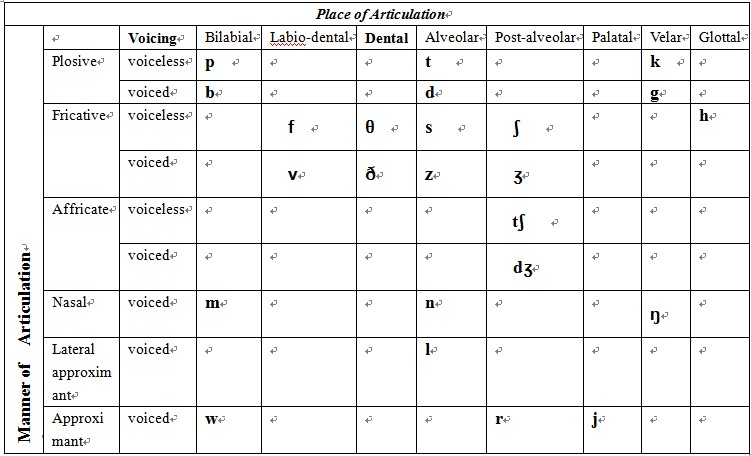3.1.1. Place of articulation
- Bilabial - use of both lips, e.g. /p/, /b/, /m/ and /w/
- Labio-dental - upper teeth and lower lip /f/ and /v/
- Dental - upper and lower teeth and tip of tongue /θ/ and /ð/
- Alveolar - tip of tongue touches ridge behind teeth /t/ and /d/, /n/ and /l/;
- blade of tongue touches ridge behind teeth , /s/ and /z/
- Palato-alveolar (post-alveolar) – tongue touches the front part of the palate (roof of mouth) /ʃ/, /ʒ/, /tʃ/, /dʒ/, /r/
- Palatal - tongue touches the middle of the palate /j/
- Velar - back part of tongue touches soft palate /k/ and /g/, /ŋ/
- Glottal - opening in vocal tract when vocal chords part /h/
3.1.2. Manner of articulation
- Plosive / stop: Air stream is blocked completely → release of air e.g. /p/, /b/, /t/, /d/, /k/, and /g/
- Fricative: Air escapes through a small passage à hissing sound e.g. /f/, /v/, /θ/, /ð/, /s/, /z/, /ʃ/, /ʒ/, and /h/
- Affricate: plosive + fricative e.g. /tʃ /and /dʒ/
- Nasal: Air exits thru the nose e.g. /m/, /n/, and /ŋ/
- Lateral: Air exits along the sides of the tongue e.g. /l/
- Approximant: A consonant with very little obstruction to the airflow
- e.g. /w/, /j/, and /r/
- semi-vowels: /w/&/j/
- retroflex/ rhotic: /r/
- e.g. /w/, /j/, and /r/
3.1.3. Voicing
Voicing is the result of the vibration of the vocal cords. In acoustic analysis, the most important thing with regards to voicing is the low frequency area at the bottom of the spectrogram in the frequency range from 0 to approximately 200Hz. This greater darkness is referred to as a voicing bar, and is a primary indicator of voicing in the spectrogram.
Hits: 7479

